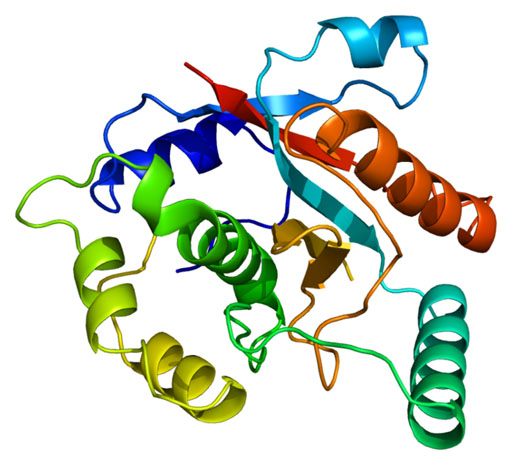Enzyme Identified Promotes Cancer Development by Mishandling Repair of DNA Breaks
By LabMedica International staff writers
Posted on 22 Dec 2016
Cancer researchers have identified an enzyme linked to defective repair of damaged DNA, which is a mechanism that prevents cell death and mediates transformation into a cancerous state.Posted on 22 Dec 2016
Homologous recombination (HR) is one of the major DNA double-strand break repair pathways in mammalian cells. Defects in HR trigger genomic instability and result in cancer predisposition. The defining step of HR is homologous strand exchange directed by the protein RAD51 (RAD51 recombinase), which is recruited to double-strand break repair by BRCA2 (Breast cancer 2). However, the mechanism that regulates the BRCA2–RAD51 interaction has not been defined.

Image: A molecular model of the UCHL3 (Ubiquitin carboxyl-terminal hydrolase isozyme L3) enzyme, a critical regulator of double-strand DNA repair (Photo courtesy of Wikimedia Commons).
To better understand this aspect of DNA repair, investigators at the Mayo Clinic (Rochester, MN, USA) searched for the enzyme responsible for the ubiquitination and deubiquitination of RAD51, since ubiquitination of RAD51 hindered RAD51–BRCA2 interaction (leading to cell death), while deubiquitination of RAD51 facilitated RAD51–BRCA2 binding and RAD51 recruitment and thus was critical for proper HR (leading to cancer development).
The investigators reported in the December 9, 2016, online edition of the journal Genes & Development that in response to DNA damage, the deubiquitinase enzyme UCHL3 (Ubiquitin carboxyl-terminal hydrolase isozyme L3) was phosphorylated and activated by ATM (ATM serine/threonine kinase). ATM is a serine/threonine protein kinase that is recruited and activated by DNA double-strand breaks. It phosphorylates several key proteins that initiate activation of the DNA damage checkpoint, leading to cell cycle arrest, DNA repair, or apoptosis.
The investigators found that UCHL3 deubiquitinated RAD51 and promoted the binding between RAD51 and BRCA2. Overexpression of UCHL3 rendered breast cancer cells resistant to radiation and chemotherapy, while depletion of UCHL3 sensitized cells to these treatments, suggesting a determinant role of UCHL3 in cancer therapy.
"DNA encodes the blueprints for our body, and DNA repair is a fundamental mechanism to prevent the accumulation of mutations in DNA and human disease," said senior author Dr. Zhenkun Lou, a molecular pharmacologist at the Mayo Clinic.
"The BRCA2 pathway is important for DNA repair, and mutation of the BRCA2 gene is linked to increased cancer risk, especially breast cancer and ovarian cancer. UCHL3 could be a potential therapeutic target to overcome resistance to chemotherapy in cancer cells that have a high level of UCHL3. While more research is needed, our studies may provide a novel therapeutic venue to treat women's cancer and thereby contribute to the health and welfare of women."
Related Links:
Mayo Clinic













